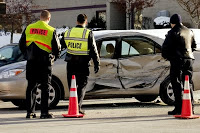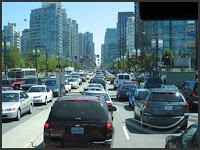Tag Archive: road rage

Where Is Road Rage The Worst?
May 19, 2016
A new survey has come out listing those states and cities with the worst instances of road rage. This study, using some different methodology has some surprising results compared to studies in the past.
Past studies we have written about were sponsored by AutoVantage, an online insurance company. To conduct those studies, AutoVantage conducted phone interviews with 2500 drivers in 25 major metropolitan areas. The latest study, conducted by AutoInsuranceCenter, another online insurance company, looked at 65,535 Instagram posts that were hashtagged #RoadRage. The results of this study showed where and when the greatest number of road rage incidents were happening.
According to the Instagram posts, the greatest number of road rage incidents occurred:
- During the month of August.
- On Fridays.
- During the hours of 5:00pm and 7:00pm.
Surprisingly, the state with the greatest number of Instagram road rage posts was Hawaii. A vacation paradise isn’t normally what most people would connect with road rage. However, as anyone who lives in a tourists center, like Orlando for example, knows large numbers of tourists trying to navigate around a strange city can be extremely frustrating. Tourists also tend to bring their bad and discourteous driving behaviors with them when they go on vacation and that can also be very frustrating.
The last AutoVantage study listed Houston, followed by Atlanta as the cities where road rage was most likely to be encountered. The new study by AutoInsuranceCenter lists Los Angeles, followed by New York City as the worst cities. Houston and Atlanta fell to eighth and tenth place respectively.
A study that depends on Instagram messages may not be highly accurate because it depends on people posting an Instagram while they’re still angry enough to do something about it. If they were to wait until they got home, they may have calmed down enough to let it go. However, drivers who tend to post on Instagram while driving are probably adding to the problem by not watching the road ahead.
To avoid road rage situations:
- Pay attention to the road ahead.
- Don’t use your phone or try to send or read any kind of messages while driving.
- Don’t speed but don’t drive too slowly either.
- Don’t tailgate.
- If you aren’t sure where you are or where you’re going, get off the road long enough to get your bearings so that you don’t hold up traffic.
- Don’t respond to an angry driver.
- Don’t try to retaliate against another driver, no matter what they may have done.
- Don’t stop to confront an angry driver.
- When dealing with an angry driver, never roll down your windows or get out of your car.
For more information, visit: #RoadRage – Instagram Posts Reveal America’s Biggest Frustrations Behind the Wheel

Ask The Driving School Instructor: Aggressive Driving VS Road Rage
July 14, 2014
Question: Is there a difference between aggressive driving and road rage?
Answer: There is definitely a difference between the two. Aggressive driving refers to drivers who seem to be in a great hurry and violate two or more traffic laws at the same time. For instance, an aggressive driver may speed and tailgate at the same time or speed and run a red light. Aggressive drivers are extremely dangerous and if you encounter one, you want to do whatever you can to safely get out of his or her way and let them pass.
While aggressive driving can lead to a road rage situation, being an aggressive driver doesn’t necessarily mean you will become a road rager. Road rage occurs when a driver, for whatever reason, becomes so angry at another driver that he or she wants to physically harm the other driver. Road rage is actually a form of temporary insanity where a driver becomes so enraged that they lose contact with reality and feel it is not only OK to harm another driver but that they can safely get away with it because they feel justified in their actions. Even normally safe drivers can allow themselves to be pushed over that psychological tipping point into a road rage situation if they feel that other drivers are taking advantage of them. Road rage situations happen on a weekly basis in the US and drivers have been killed in all 50 states in road rage incidents.
To avoid a road rage situation, you should be courteous to other drivers at all times. Here are some actions to take to avoid making other drivers angry:
- Never tailgate another driver
- Don’t speed but don’t drive slower than the speed limit either if the roadway is clear ahead.
- Stop at red lights and be ready to go, if the way is clear, as soon as the light turns green.
- Stay out of the left (passing) lane unless you are actually passing another vehicle and then move back to the right lane as soon as it is safe to do so.
- If someone wants to pass, help them by pulling slightly to the right and slowing a little to allow them to pass.
- If someone is tailgating you, let them pass by moving out of their way as soon as it is safe to do so.
- Don’t cut off another driver.
- Put down your cell phone and pay attention to the driving situation.
If you feel you may be in a road rage situation:
- Don’t stop your vehicle unless the traffic situation makes it impossible to move safely.
- Never get out of your vehicle or open your window to speak to the other driver.
- Call 911 immediately and tell them of your situation, make sure the other driver can see you on the phone.
- Don’t try to reason or argue with an enraged driver; they are past the ability to reason and they just want to harm you.

5 Things A Teen Driver Must Do To Handle A Crash
May 9, 2011
If you compare industrialized nations, some may say the US has a poor record of teaching young drivers how to drive. Instead of the requirement to be taught by professional driving instructors, American teens are taught to drive by their parents who, with few exceptions, are ill prepared to teach their teen how to drive. As a result, many teens are sent out on the road without the proper training or experience to handle a lot of the driving situations they will be faced with. Unfortunately, in the United States, that means that the chances of a teen becoming involved in a collision within the first year of driving are very high. Since the chances of a teen driver being involved in a motor vehicle collision are so high, teens should, at least, be prepared to deal with the aftermath of a crash.
Here’s a brief checklist of what a teen driver must know, when involved in a crash:
Don’t place blame, remain calm – This is much easier said than done given the emotions involved in a crash however, remaining calm can help defuse a potentially volatile situation. Tempers can flare after a crash and there is the potential for a “road rage” attack. Losing one’s calm can’t “un-crash” the vehicles so it is imperative that the teen remain as calm as possible. If the other driver becomes confrontational, stay in the car and wait for the police. There may be a temptation to run but the teen should be aware that he or she could be arrested for leaving the scene of a collision.
Check immediately for injuries to other drivers. Call Rescue, if necessary. – If anyone involved was hurt, the first priority is to call 911 for medical assistance. First aid should be applied to stop bleeding but, to prevent even greater injuries, an injured victim should never be moved unless there is a greater chance of further injury from fire or a secondary collision from oncoming traffic. Never give injured victims any water.
Emergency packs – Your car should be stocked with first-aid kits, emergency flares or reflectors, tools, and any other items that may help in case of a crash. Reflective triangles or flares placed at least 100 feet away from the crash will help to divert other traffic away from the crash site. If the collision occurred around a sharp curve or other obstruction, someone should be sent to wave down or otherwise warn oncoming traffic of the danger ahead.
If the vehicles can be moved, they should be moved off the roadway as quickly as possible. If the vehicles can’t be moved, all victims who are capable of walking should be moved well off the roadway to a safe location to avoid secondary collisions.
License, insurance, and registration – Your teen should always know where the vehicle’s registration and proof in insurance card are located. They should always be kept together in an envelope in the glove box. Most state laws require that drivers who are involved in a crash share their driver’s license number, vehicle registration, proof of insurance, and current address with law enforcement officers and other persons involved.
In most states, if a collision results in more than $500 in damages either to vehicles, or public or private property, the police must be called. If the police are not called, a formal report must be made to local law enforcement within 24 hours.
Documentation – Nowadays, with cell phones, a camera is never far away. Take pictures of the crash site and any damages that may have occurred. Note and take pictures of conditions, such as weather, roadway hazards, or whether or not the sun’s position may have blinded a driver, etc. Get the names and phone numbers of any witnesses. If the collision results in a court case, having as much documentation as possible will help.
A car crash is no time to panic or lose one’s cool. Handle it properly and there will be fewer hassles, in the long run, for the teen driver.

Are you an Aggressive Driver
January 12, 2010
Well are you? Have you ever found yourself in a situation, where a driver cuts off on the highway, a driver in front is braking erratically, or even simply driving below the speed limit? How did you react to this? Some people would simply put up with it, it probably wouldn’t even affect others, but a few of us get wound up and angry at this person, and sometimes can end up lashing out. Does this sound like you? A recent survey of 526 motorists found that within the previous 12 months almost 90% stated that they had experienced behavior that could be classified as road rage.
Aggressive driving can involve a number of things and situations, including following too close, speeding, weaving through traffic, using your horn excessively, not obeying traffic safety rules, verbally lashing out at over drivers and passengers in your vehicle, even just mentally condemning them for whatever they did to anger you! But have you ever stopped to think about the other driving that you’re condemning?
- 52% of drivers say they have experienced verbal abuse or gestures from another driver.
- 9% said they had been forced to pull over or forced completely off the road, while 3% said another driver had got out of their car and threatened them with violence.
Sometimes people drive the way they do for valid reasons. Have you ever thought a driver could be breaking randomly because of a screaming baby, a loose pet, or even because there is a bee in the car? That maybe a car cut you off because there’s an emergency? Always put yourself in the other driver’s shoes.
Admittedly however, you will come across some bad drivers in your lifetime, but it’s important that you control your anger, and learn how to handle situations effectively so as not to loose your temper, because aggressive driving does not have a positive outcome.
If you are seen and reported driving aggressively, or find yourself in an accident or situation because of your aggressive driving and face all sorts of penalties, such as fines, driving bans, prosecution, community sentence, compensation pay-out to the victim of your rage, and in more severe cases, you could even face jail.
If you suffer from aggressive driving and road rage, stop and think about what you could be facing, and what you could risk losing if you persist. But there are ways you can reduce your aggression and rage, in order to become a safe driver again.
Always get your sleep, don’t stay out all night when you know you have to be up early. We all know we can get irritable and cranky when we don’t have enough sleep. Tiredness is one of the main causes of road rage and aggressive driving, according to the National Sleep Foundation. So make sure you stock up on those Z’s!
Perhaps change the music you listen to. There’s an age old argument that says aggressive music leads to aggressive people, this isn’t strictly true in most cases, but what music you listen to can effect your driving. Aggressive or bass driven music can get you pumped up and ready for action! If you know your music effects you, then change it, you don’t have to drive along to classical if you don’t want, try listening to audio books, or even a comedy station. Listening to comedy can especially lighten our moods, and it can even drown out the traffic noise! Give it a try, it might help.
And do you ever actually leave yourself enough time to get to work? Being late can make us stressed and angry, if you allow yourself enough time to get to work make it through the traffic, if it’s the traffic that’s making your angry, try leaving early to beat it, or even just finding an alternative route. Couple this with some comedy radio or relaxing music, and you’re on the road to calm!
And always remember it’s not about you. Drivers are not out to specifically get you angry, you are not the target, like I said before, perhaps they have a reason? Roll your window down, and take deep breaths to calm yourself if you feel yourself getting angry, it sounds silly, but it does work.
If you think your aggressive driving is really bad, and these techniques are not helping, then there are groups you can join that can take your problem to the root, and give you more extensive techniques in order to help you.
Remember, aggressive driving is not okay, it’s dangerous and you could be risking far more than your money and your freedom. Take steps today to curb your road rage and work your way towards a better driving life today.
